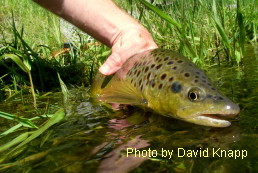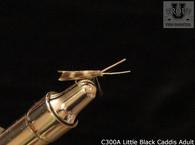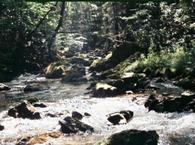
The Farmington River is a super tailrace stream with its two major branches originating in southwest Massachusetts. The West Branch of the Farmington River starts in Becket, Massachusetts and flows southeasterly to Otis, Massachusetts. The East Branch joins the West Branch at New Hartford, Connecticut and the combined waters flow through Farmington, Connecticut before emptying into the Connecticut River in Windsor. In all, from the longest branch to the Connecticut River it is 81 miles long.
It is the West Branch of the Farmington River in north central Connecticut, stocked with brook, brown and rainbow trout that captures the interest of fly fishermen. The uppermost reaches of the West Branch of the Farmington River are from Hogback Dam to Riverton and consist of riffles, runs and clear pools with excellent fishing for trout averaging 12 to 15 inches. Access is easy from the Hogback and East River Road parking areas.
From Riverton, aided by the waters from the Still River, the West Branch assumes the character of a larger river with deep pools pockets, runs and riffles. This section is again just as productive or more productive than the upper reaches and can be accessed from the local roads as well.
The nearly four miles of the Upper Trout Management Area starts one pool above the Pleasant Valley bridge on Rt. 318 and continues down to the New Hartford bridge on Rt 219 and argueably enjoys the most fishing pressure. In the large pools such as the Church Pool, the Boneyard, and Greenwoods, holdovers comprise 35 percent of the trout's population, and fish larger than 20 inches can sometimes be taken. Little wonder it is a favorite among fly fishermen, the Trout Management Area has deep slow moving wide open pools and trees to provide ample amounts of shade as well. Fly fishermen can delight in the hatches of mayflies, stoneflies, and caddisflies. The numerous trout are both wild and stocked; and like any good tailwater stream, there are the large holdovers that can be enticed into hitting a dry fly on occasion. Once again, the West Branch is accessible from secondary roads as well as Routes 44 and 181. From here south to Collinsville, the tailwater continues to be cool enough to support a large population of trout with the large brown trout ruling the large pockets and undercuts.
After leaving Collinsville the water remains a little too warm to support a good population of trout however, on occasion, you may see a few nearer to Collinsville.
In addition to the West Branch, there are several feeder streams that are stocked by the state and are worthy of mentioning. They are the East and West Branches of the Salmon Brook, as well as the Roaring Brook, Sandy Brook, Cherry Brook, Mill Brook, Pequabuck River, and as previously mentioned, the Still River
Fishing the West Branch of the Farmington River:
The cold water is released from the bottom of the Colebrook Lake and the West Branch Reservoirs so it maintains a fairly constant, even flow and a reasonably even temperature year around. There are sufficient nutrients in the water capable of supporting an abundance of aquatic insects. The West Branch flows through some beautiful surroundings and is well stocked but be careful when wading due to some of the deeper pools and larger boulders. It is suggested that you keep your wading staff handy and of course, wear your good wading boots for safety.
Spring:
The early-season hatches from April to early June include blue winged olives, and blue quills followed by the hendricksons. Dry imitations of duns and spinners will work well in the seams and don’t forget to put some of the nymphs and the emergers in your fly box.
Summer:
The March Browns followed by sulphurs and the light cahills will provide sufficient activity in the early summer. Long and light tippets would be the order of the day to match the hatch on those long slow pools. Of course terrestrials like hoppers and flying ants should be in your fly box as well.
Fall:
The fall is a good time to fish the West Branch of the Farmington due to the great scenery as well as the excellent fall fishing. There will still be hatches of the tricos, blue winged olives and blue duns with some late terrestrials lingering around.
Winter:
The Farmington does not freeze over in the winter so there can be good fishing in those months. Nymphs of the midges will be your most productive flies during this time of year supplemented with streamers.
Easy access is provided by the many roads in the area. Major hikes are not necessary.
(Angles's guide) Connecticut Fishing Regulations
Hatch Guide for New England Streams by Thomas Ames Jr, available at Amazon.
View New England in a larger map





